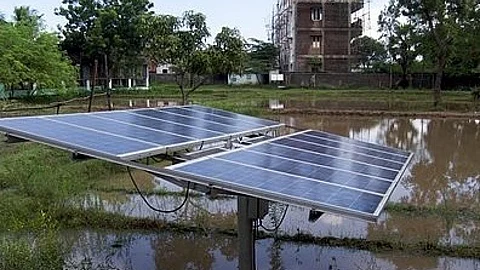
- Topics
- Feature
- Opportunities & Events
- Data
- Hindi Portal
- Topics
- Feature
- Opportunities & Events
- Data
- Hindi Portal

The present government has set a target of 100 gigawatts (GW) of solar power capacity for the country by 2022. The paper titled 'India’s 100GW of solar by 2022: Pragmatism or targetitis?' published in the Economic and Political Weekly, informs that solar energy is indeed an important and desirable component in the larger target of 175GW by 2022 for renewable energy-based power, which has the capacity to increase the share of renewable energy in electricity generation from 7% to 18.9%. However, it is important to assess whether the target of 100GW solar by 2022 is realistic or simply a nice looking number.
The 100GW target is five times more than the Jawaharlal Nehru National Solar Mission (JNNSM) target of 10GW solar capacity by the end of 2017 and 20GW by the end of the next Five Year Plan, that is in 2022. The JNNSM target was based on an expected fall in solar production costs and achievement of grid parity by 2022 and the revision of the JNNSM target is a good development since the price of solar photovoltaic (PV) has dropped by 60% between 2010 and 2014. However, with the current trends in the fall of solar PV, grid parity is expected to be achieved as early as 2017.
The paper argues that the price is not the only challenge to overcome to achieve the 100GW target by 2022. There are issues relating to land, manufacturing and technology among others that need to be dealt with.
Of the 100GW target, 60GW are ground-mounted medium to large scale solar power plants that need land. Since solar plants require as much land as conventional power plants, that will amount to around 1% of the total culturable wasteland and 1.2% of the total fallow land of the country. Although solar plants do not transform, degrade or submerge lands as in case of mining or damming, acquisition of large amounts of land from farmers can be difficult. In such as situation, there could be two options:
However, more studies and on field experiments are needed to establish the impact on crops, the engineering of the frames carrying the panels and their cost, and the safety of farmers working below the panels.
The grid-connected rooftop forms the second component of the 100GW target and has a 40GW share. With regulations that include compulsory utilisation of rooftop space and incentives like net metering and feed-in tariff, rooftops can have good prospects for generating solar power. However, there are two considerations:
However, the progress in rooftop solar has been relatively slow and this is attributed to the lack of clear policies.
One of the major challenges with increasing solar use in India is the limited manufacturing capacity available.
The paper ends by arguing that India has moved in the right direction in terms of initiating certain policy instruments such as providing accelerated depreciation, local content requirement, renewable purchase obligations, renewable generation obligations, bundling of conventional and renewable electricity, etc. However, there are a number of other challenges to overcome such as financing, offtake of power, storage, and grid-management. The solar sector has long been known for its realistic goals and must not become a victim of targetitis as in the nuclear power sector. It will thus be wiser to make moderately ambitious targets and achieve them, which can help government departments win back the confidence of industries and the larger public.
Please download a copy of the paper below.